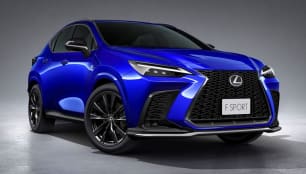The NX feels entirely different from the previous model. The new car feels bigger, wider, heavier, almost as though you’re driving the previous-generation RX, a full size up.
It’s also a completely different beast from the RAV4 on which it is based. Visibility is still excellent with expansive glass on all but the rearmost window, while the refreshed cabin design feels spacious but more luxurious, too.
The steering is heavy, regardless of drive mode, making the NX feel substantial, but not inconvenient or artificial, with some organic feedback letting you connect with the road.
The hybrid drivetrain is the real star of the show, however, with Lexus putting its decades of experience on full show.
The car defaults to EV priority mode, moving primarily as an electric car at up to freeway speeds without needing the combustion components.
In hybrid vehicle mode, the components (which are the same as the standard hybrid, anyway) do an excellent job of mimicking the series/parallel drive of other Lexus and Toyota hybrid models.
The key brilliance of this system is how drive to the wheels is managed by the transmission, so it is imperceptible to the driver when the engine is assisting (aside from distant noise at higher loads).
The mastery of this tech is such that it is still the leading hybrid drive on the market for smooth power transfer.
The NX also has a charge mode, where it will operate primarily as a combustion vehicle with less electrical assistance. The idle time from the engine is used to charge the battery via the transmission.
While it’s not an efficient way to use the energy, it may be useful for where you want to maximise the amount of energy saved during a freeway trip in order to have a full charge for emissions free motoring at your destination.
The only area of drivetrain customisation I wish the NX had is in regeneration. The stock regen tune is quite mild, so I feel as though it could get even more range out of EV priority mode if you were able to maximise this.
The NX is also quite fast in a straight line, with Sport and Sport+ modes allowing you to eke otherwise hidden performance out of the electric motors.
Raw acceleration does make the 6.3-second claimed 0-100km/h time feel like a realistic proposition, but I wouldn't put this SUV in amongst its performance rivals.
While its electrified straight-line performance is impressive, the each-way suspension tune and weight of 18.1kWh of batteries leaves a little to be desired on the handling front.
This car feels its weight in the corners and comes with a fair bit of body-roll to keep it out of the same league as German sports machines like the GLC53 or BMW X3 M40i.
The suspension tune was another source of disappointment. For context, the ride is generally very good, but I found the large wheels, low profile tyres, and new adaptive suspension package give the NX a ride with a harsher edge than I was expecting.
This is perhaps more notable because its RAV4 relation is particularly good for ride comfort. Seems odd that the relatively affordable Toyota-branded SUV rides with more grace than its Lexus luxury equivalent.
The same goes for road noise. Not bad, but it could be better on coarser chip surfaces, where you can hear the difference the big Lexus wheels and low-profile rubber makes.
Where does that leave us? This is a more luxury-oriented model when it comes to its ride and handling than some of its price-equivalent sporty rivals, but leans into its electric features to provide a customisable platform for energy-efficient adventures.
It’s silky smooth around town but leaves you with the confidence to have some battery left at the end of your trip without making it too complicated. I’d argue the ingredients on offer here are what more manufacturers should be combining to get people into PHEVs.

